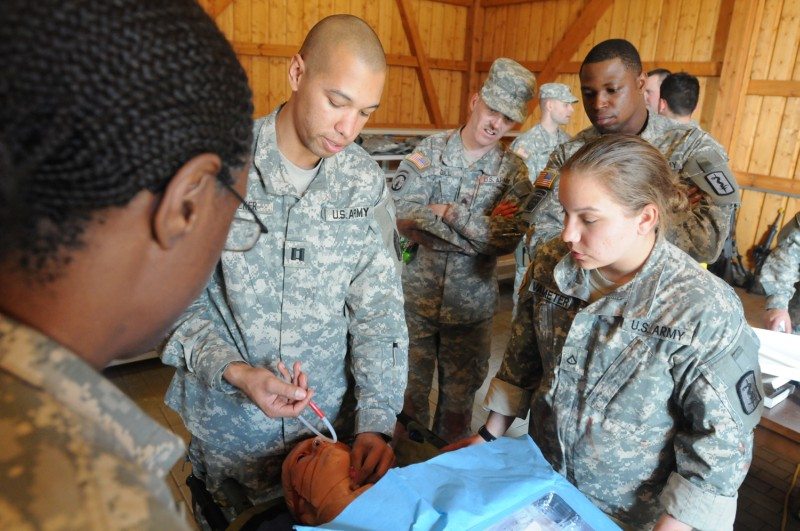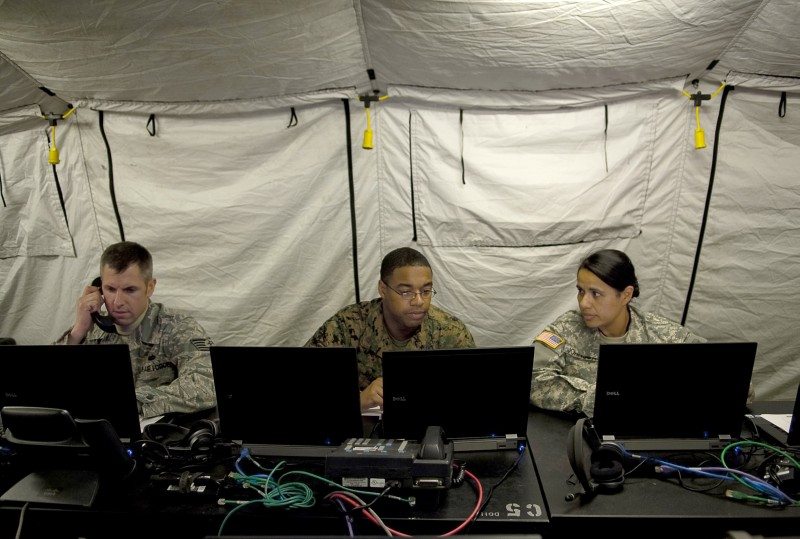Entering the building you become engulfed by darkness. Thick smoke fills the air, and gunfire pierces your ears.
As your boots slip across the blood soaked floor, you find that there are bodies of injured Soldiers lying around the room. It’s up to you and your battle buddy to rapidly identify the casualties’ injuries, and immediately provide medical care. These split-second decisions can make the difference between life and death.
When the mission is completed the doors of the Medical Simulation Training Center open and sunlight shines in on the numerous simulated casualties.
The Soldiers of the 30th Medical Command’s 557th Medical Company (Area Support) used the state-of-the-art MSTC facility here March 28 to April 1, to gain valuable experience and refine their combat medical skills.
“We wanted to take advantage of the opportunity to give our medics and combat-lifesavers some excellent real-world type training on these simulators,” said Sgt. 1st Class Richard Kling, the 557th ASMC first sergeant.
During the scenarios, a combat medic was teamed up with a combat lifesaver to treat various simulated casualties. The wounded Soldiers, though simulated, are able to replicate many human characteristics, according to Joe Aubihl, the lead instructor for the MSTC.
“They breathe, bleed, talk, and blink. They can have unilateral or bilateral rise and fall of the chest,” Aubihl explained. “They can do a lot.”
These “sim-men,” as they’re known, give real-time feedback to the medics – a training value that simply can’t be replicated elsewhere.
“This allows them to actually work on a breathing, bleeding casualty. Granted, it’s not a human being, they don’t move around too much. But it’s getting away from the days of putting tape on someone’s arm saying that they have an amputation or chest wound,” Aubihl said.
The 557th ASMC, the only area support medical company in Europe, is designed to simultaneously provide level I and II medical care. The MSTC instructors and the noncommissioned officers of the 557th worked together to adapt the training to the unit’s unique mission.
“We created this circular lane that goes from point of wound care, to tactical field care, to level II echelon care and evac,” said Aubihl.
This led to an invaluable experience for the unit’s medics and combat lifesavers, according to Kling.
“Our headquarters is composed of cooks, supply Soldiers, mechanics, admin operations – the usual headquarters type set up,” Kling said. “When we have the main aid station set up and our teams pushed out, the headquarters is always with the main aid station. So in the event of [numerous casualties], we have our medical personal and these combat lifesavers to assist.”
For the combat medics, the training is both challenging and beneficial.
“The stress level helps us to learn how to work through things under difficult circumstances. This really helps get more confidence in your skills and recognize what you need to work on,” said Pfc. Lashun Douglas, a 557th ASMC combat medic. “When I first went through I was all over the place. The more times I go through, I’ve gained some confidence and focus.”
The experience of working on responsive patients is priceless, and the MSTC facility allows the Soldiers to repeatedly practice processes and steps that will save lives.
“Imagine if they can put in a [chest tube] 100 times before they have to put a real one in. Repetition is the key to adult learning, and you get to do it here. Yeah, it’s going to be a little different and a little more intense in real life, but they’ll be able to just fall back on the training that they’ve had,” said Capt. Avery Walker, a doctor at the Stuttgart Army Health Clinic.
“They need to be able to do this in their sleep and coming out here makes it that much easier,” said Walker.
The 557th ASMC, headquartered in Wiesbaden, Germany, was in the area providing medical support during the 172nd Separate Infantry Brigade’s mission rehearsal exercise at the Joint Multinational Training Command in Grafenwoehr and Joint Multinational Readiness Center in Hohenfels.
Story and photos by Sgt. 1st Class Christopher Fincham, 30th MEDCOM Public Affairs NCOIC. For more information please contact him at [email protected].











